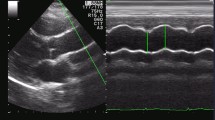Abstract
To non-invasively determine abdominal aortic properties, a five-element lumped circuit model was adopted. The model consists of resistance due to blood viscosity (R1), inertia of blood flow, compliances of the vessel (C1, C2), resistance of the peripheral arteries (R2) and the impedance of the femoral arteries (termination). Patterns of the central velocity of the upper abdominal aorta and the femoral artery are measured by pulsed Doppler echocardiography, and confours of flow volume rates are calculated. The pressure pattern of the lower limb is recorded by a pulse wave rransducer and corrected according to sphygmomanometer values. Contours are transformed into respective Fourier transform components. The current transfer function is described theoretically and calculated from the acquired Fourier components. Values of every element are evaluated by the nonlinear least squares method. In 94 subjects (17–92 years), the values of each element are estimated. R2 values are greater in the elderly group, than in the young group and r1 (R1/cm) increased with age. This model demonstrates that vessel compliance (c1+c2 (C1+C2/cm)) decreases with age, and it is suggested that this may be a useful marker of arteriosclerosis.
Similar content being viewed by others
References
Avolio, A. P., Deng, F., Li W., Luo, Y., Huang, Z., Xing, L., andO’rourke, M. F. (1985): ‘Effects of aging on arterial distensibility in populations with high and low prevalence of hypertension: comparison between urban and rural communities in China’,Circ. 71, pp. 202–210
Avolio, A. P., Chen, S., Wang, R., Zhang, C., Li, M. andO’Rourke, M. F. (1983): ‘Effects of aging on changing arterial compliance and left ventricular load in a northern Chinese urban community’,Circ.,68, pp. 50–58
Bader, H. (1967): ‘Dependence of wall stress in the human thoracic aorta on age and pressure’,Circ. Res.,20, pp. 354–361
Burattini, R., Knowlen, G. G. andCampbell, K. B. (1991): ‘Two arterial effective reflecting sites may appear as one to the heart’,Circ. Res.,68, pp. 85–99
Eliakim, M., Sapoznikov, D. andWeinman, J. (1971): ‘Pulse wave velocity in healthy subjects and in patients with various disease states’,Am. Heart J.,82, pp. 448–457
Hyams, D. E. (1985): ‘The blood’in Brocklehurst, J. C. (Ed.) ‘Textbook of geriatric medicine and gerontology’, (Churchill Livingstone, Edinburgh), pp. 835–898
Jager, G. N., Westerhof, N. andNoordergraaf, A. (1965): ‘Oscillatory flow impedance in electrical analog of arterial system’,Circ. Res.,16, pp. 121–133
Li, J. K. J., Melbin, J., Riffle, R. A. andNoordergraaf, A. (1981): ‘Pulse wave propagation’,Circ. Res.,49, pp. 442–452
Milnor, W. R. (1989): ‘Hemodynamics’Collins, N. (Ed.) (Williams & Wilkins, Baltimore) 2nd edn.
Nichols, W. W., Conti, C. R., Walker, W. E. andMilnor, W. R. (1977): ‘Input impedance of the systemic circulation in man’,Circ. Res.,40, pp. 451–458
Nicols, W. W. andO’rourke, M. F. (1990): ‘Pulsatile pressure/flow relations’,in ‘Blood flow in arteries’, (Edward Arnold, Hodder & Stoughton, London) pp. 398–420
O’rourke, M. F. andAvolio, A. P. (1980): ‘Pulsatile flow and pressure in human systemic arteries’,Circ. Res.,46, pp. 363–372
Powell, M. J. D (1965): ‘A method for minimizing a sum of squares of non-linear functions without calculating derivatives’,Comput. J.,7, pp. 303–307
Sakanishi, A. andHasegawa, M. (1982): ‘Nonlinear model of blood vessels for pulse wave propagation’,Reports Progr Polymer Phys. Jpn.,25, pp. 815–816
Schutz, D. L. (1972): ‘Pressure and flow in large arteries’in Bergei., D. H. (Ed.), Cardiovascular fluid dynamics Vol. 1, (Academic Press, London) pp. 287–314
Simon, A. C., Safar, M. E., Levenson, J. A., London, G. M., Levy, B. I. andChau, N. P. (1979): ‘An evaluation of large arteries compliance in man’,Am. J. Physiol.,237, H550-H554
Toorop, G. P., Westerhof, N. andElzinga, G. (1987): ‘Beat-to-beat estimation of peripheral resistance and arterial compliance during pressure transients’,Am. J. Physiol.,252, pp. H1275-H1283
Westerhof, N., Bosman, F., De Vries, C. J. andNoordergraaf, A. (1969): Analog studies of the human systemic arterial tree’,J. Biomech.,2, pp. 121–143
Womersley, J. R. (1955a): ‘Method for the calculation of velocity, rate of flow and viscous drag in arteries when the pressure gradient is known’,J. Physiol.,127, pp. 553–563
Womersley, J. R. (1955b): ‘Oscillatory motion of a viscous liquid in a thin-walled elastic tube I: the linear approximation for long waves’,Phil. Mag.,46, pp. 199–221
Womersley, J. R. (1957): ‘An elastic tube theory of pulse transmission and oscillatory flow in mammalian arteries’. Wright Air Development Center, Technical Report TR 56-614 pp. 56–614.
Woolam, G. L., Schnur, P. L., Vallbona, C. andHoff, H. E. (1962): ‘The pulse wave velocity as an early indicator of atherosclerosis in diabetic subjects’,Circ. 25, pp. 533–539
Author information
Authors and Affiliations
Rights and permissions
About this article
Cite this article
Morishita, K., Kambe, M. Non-invasive evaluation of abdominal aortic properties: lumped circuit model and estimation of its parameters. Med. Biol. Eng. Comput. 33, 699–703 (1995). https://doi.org/10.1007/BF02510789
Received:
Accepted:
Issue Date:
DOI: https://doi.org/10.1007/BF02510789




